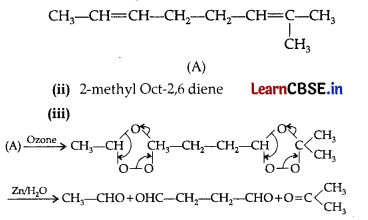Students must start practicing the questions from CBSE Sample Papers for Class 11 Chemistry with Solutions Set 2 are designed as per the revised syllabus.
CBSE Sample Papers for Class 12 Chemistry Set 2 with Solutions
Time Allowed : 3 hours
Maximum Marks: 70
General Instructions:
- There are 33 questions in this question paper with internal choice.
- Section – A consists of 16 multiple -choice questions carrying 1 mark each.
- Section – B consists of 5 short answer questions carrying 2 marks each. ,
- Section – C consists of 7 short answer questions carrying 3 marks each.
- Section – D consists of 2 case – based questions carrying 4 marks each.
- Section – E consists of 3 long answer questions carrying 5 marks each.
- All questions are compulsory.
- Use of log tables and calculators is not allowed.
Section-A
The following questions are multiple-choice questions with one correct answer. Each question carries 1 mark. There is no internal choice in this section.
Question 1.
The number of atoms present in one mole of an element is equal to Avogadro number. Which of the following element contains the greatest number of atoms?
(A) 4 g He
(B) 46 g Na
(C) 0.40 g Ca
(D) 12 g He
Answer:
(D) 12 g He
Explanation:
Greater the number of moles, greater willbe the number of atoms in an element.
Number of moles of 4 g He = 4/4 = 1 mol
Number of moles of 46 g Na = 46/23 = 2 mol
Number of moles of 0.40 g Ca = 0.40/40 = 0.01 mol
Number of moles of 12 g He = 12/4 = 3 mol As,
Number of moles is highest in 12 g He. So it contains greatest number of atoms.
Question 2.
The quantum number which determines the size and energy of the orbital:
(A) Azimuthal quantum number
(B) Spin orbital quantum number
(C) Principal quantum number
(D) Magnetic orbital quantum number
Answer:
(C) Principal quantum number
Explanation:
Principal quantum number determines the size and energy of the orbital.
![]()
Question 3.
Which of the following statement is not correct about the characteristics of cathode rays? 1
(A) They start from the cathode and move towards the anode.
(B) They travel in straight line in the absence of an external electrical or magnetic field.
(C) Characteristics of cathode rays do not depend upon the material of electrodes in cathode ray tube.
(D) Characteristics of cathode rays depend upon the nature of gas present in the cathode ray tube.
Answer:
(D) Characteristics of cathode rays depend upon the nature of gas present in the cathode ray tube.
Explanation:
The characteristics of cathode rays do not depend on the nature of gas present in cathode ray tube and material of electrodes.
Question 4.
The electronic configuration of dysprosium (atomic number 66) is:
(A) [Xe]4f
5
5d
5
6s
2
(B) [Xe]4f1
4
4d
9
6s
2
(C) [Xe]6s
2
4f
14
(D) [Xe]4f
13
4d
10
6s
2
Answer:
(C) [Xe]6s
2
4f
14
Question 5.
Thermodynamics is not concerned about ……..
(A) energy changes involved in a chemical reaction.
(B) the extent to which a chemical reaction proceeds.
(C) the rate at which a reaction proceeds.
(D) the feasibility of a chemical reaction.
Answer:
(C) the rate at which a reaction proceeds.
Explanation:
Thermodynamics is not concerned about how and at what rate these energy transformations are carried out, but is based on initial and final states of a system undergoing the change.
![]()
Question 6.
Which of the following statements is correct?
(A) The presence of reacting species in a covered beaker is an example of open system.
(B) There is an exchange of energy as well as matter between the system and the surroundings in a closed system.
(C) The presence of reactants in a closed vessel made up of copper is an example of a closed system.
(D) The presence of reactants in a thermos flask or any other closed insulated vessel is an example of a closed system.
Answer:
(C) The presence of reactants in a closed vessel made up of copper is an example of a closed system.
Explanation:
- The presence of reacting species in a covered beaker is an example of closed system,
- In a closed system, there is no exchange of matter, but exchange of energy is possible between system and the surroundings,
- The presence of reactants in a thermos flask or any other closed insulated vessel is an example of an isolated system.
Question 7.
During complete combustion of one mole of butane, 2658 kJ of heat is released. The thermochemical reaction for above change is:
(A) 2C
4
H
10
(g) + 13O
2
(g) → 8CO
2
(g) + 10H
2
O(l); ∆
c
H = – 2658.0 kJ mol
-1
(B) C
4
H
10
(g) + \(\frac{13}{2}\) O
2
(g) → 4CO
2
(g) + 5H
2
O(g); ∆
c
H = -1329.0 kJ mol
-1
(C) C
4
H
10
(g) + \(\frac{13}{2}\)O
2
(g) → 4CO
2
(g) + 5H
2
O(l); ∆
c
H = – 2658.0 kJ mol
-1
(D) C
4
H
10
(g) + \(\frac{13}{2}\)O
2
(g) → 4CO
2
(g) + 5H
2
O(l); ∆
c
H = + 2658.0 kj mol
-1
Answer:
(C) C
4
H
10
(g) + \(\frac{13}{2}\)O
2
(g) → 4CO
2
(g) + 5H
2
O(l); ∆
c
H = – 2658.0 kJ mol
-1
Question 8.
The volume of gas is reduced to half from its original volume. The specific heat will be ………..
(A) reduce to half
(B) be doubled
(C) remain constant
(D) increase four times
Answer:
(C) remain constant
Explanation:
Specific heat is an intensive property and is independent of the volume of the substance
Question 9.
Which of the following is not an example of redox reaction?
(A) CuO + H
2
→ Cu + H
2
O
(B) Fe
2
O
3
+ 3CO → 2Fe + 3CO
2
(C) 2K + F
2
-> 2KF
(D) PbCl
2
+ H
2
SO
4
→ PbSO
4
+ 2HC1
Answer:
(D) PbCl
2
+ H
2
SO
4
→ PbSO
4
+ 2HC1
Explanation:
It is not a redox reaction as there is no change in oxidation number of any of the reactants. It is an example of double displacement reaction.
![]()
Question 10.
Ee values of some redox couples are given below. On the basis of these values, choose the correct option.
E
θ
values: Br
2
/Br
–
= + 1.90: Ag
+
/Ag(s) = + 0.80
Cu
2+
/Cu(s) = + 0.34:1
2
(s)/I
–
= + 0.54
(A) Cu will reduce Br
–
(B) Cu will reduce Ag
(C) Cu will reduce I
–
(D) Cu will reduce Br
2
Answer:
(D) Cu will reduce Br
2
(D) Cu will reduce Br
2
Explanation:
If the E° of the given resultant reaction is positive then Cu will reduce Br’.

As, E° is positive, Cu will reduce Br
–
Question 11.
Thiosulphate reacts differently with iodine and bromine in the reactions given below:
2S
2
O
3
2+
+ I
2
→ S
4
O
6
–
+ 21
–
:
S
2
O
3
2-
+ 2Br
2
+ 5H
2
O → 2SO
4
2-
+ 2B
r
–
+ 10H
+
Which of the following statements justifies the above dual behaviour of thiosulphate?
(A) Bromine is a stronger oxidant than iodine.
(B) Bromine is a weaker oxidant than iodine.
(C) Thiosulphate undergoes oxidation by bromine and reduction by iodine in these reactions.
(D) Bromine undergoes oxidation and iodine undergoes reduction in these reactions.
Answer:
(A) Bromine is a stronger oxidant than iodine.
Explanation:
Bromine being stronger oxidizing agent oxidises S of S
2
O
3
2
to SO
4
2
while I
2
oxidises it only into S
4
O
6
2-
.
Question 12.
The addition of HC1 to an alkene proceeds in two steps. The first step is the attack of H+ ion to >C =C< portion which can be shown as

Answer:
![]()
Explanation:
Since, double bond is a source of electrons and the charge flows from source of more electron density, therefore, n electrons of the double bond attack the proton.
Question 13.
Given below are two statements labelled as Assertion (A) and Reason (R)
Assertion (A): A0 isotopes of a given element show the same type of chemical behaviour.
Reason (R): The chemical properties of an atom are controlled by the number of electrons in the atom. Select the most appropriate answer from the options given below:
(A) Both A and R are true and R is the correct explanation of A.
(B) Both A and R are true but R is not the correct explanation of A.
(Q A is true but R is false.
(D) A is false but R is true.
Answer:
(A) Both A and R are true and R is the correct explanation of A.
Explanation:
Chemical properties of atoms are controlled by the number of electrons, which are determined by the number of protons in the nucleus. Number of neutrons present in the nucleus have very little effect on the chemical properties of an element. Therefore, all the isotopes of a given element show same chemical behaviour.
![]()
Question 14.
Given below are two statements labelled as Assertion (A) and Reason (R)
Assertion (A): Among halogens fluorine is the best oxidant.
Reason (R): Fluorine is the most electronegative atom.
Select the most appropriate answer from the options given below:
(A) Both A and R are true and R is the correct explanation of A.
(B) Both A and R are true but R is not the correct explanation of A.
(C) A is true but R is false.
(D) A is false but R is true.
Answer:
(B) Both A and R are true but R is not the correct explanation of A.
Explanation:
As fluorine has highest electron affinity and bond energy in comparison to other halogens, so the tendency to accept a new electron is highest.
Question 15.
Given below are two statements labelled as Assertion (A) and Reason (R)
Assertion (A): Nitration of benzene with nitric acid requires the use of concentrated sulphuric acid.
Reason (R) : The mixture of concentrated sulphuric acid and concentrated nitric acid produces the electrophile, NO
2
+
.
Select the most appropriate answer from the options given below:
(A) Both A and R are true and R is the correct explanation of A.
(B) Both A and R are true but R is not the correct explanation of A.
(C) A is true but R is false.
(D) A is false but R is true.
Answer:
(A) Both A and R are true and R is the correct explanation of A.
![]()
Question 16.
Given below are two statements labelled as Assertion (A) and Reason (R)
Assertion (A): 1-Butene on reaction with HBr in the presence of a peroxide produces 1-bromo-butane.
Reason (R): It involves the free radical mechanism
Select the most appropriate answer from the options given below:
(A) Both A and R are true and R is the correct explanation of A.
(B) Both A and R are true but R is not the correct explanation of A.
(C) A is true but R is false.
(D) A is false but R is true.
Answer:
(A) Both A and R are true and R is the correct explanation of A.
Explanation: This reaction is followed by against of Markovnikov’s rule
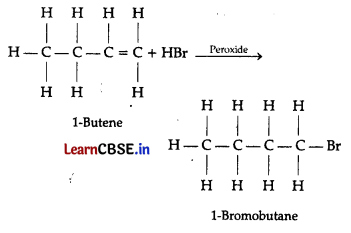
In this reaction anti Markovnikov’s addition is explained on the basis of the fact that in the presence of peroxide the addition takes place via a free radical mechanism rather than the ionic mechanism.
Section-B
This section contains 5 questions with internal choice in one question. The following questions are very short answer type and carry 2 marks each.
Question 17.
Calculate the number of moles in the following masses:
(a) 7.85 g of Fe
(b) 7.9 mg of Ca
Answer:
(a) Number of moles = 7.85 /56 = 0.1401 mol (1)
(b) 7.9 mg = 0.0079 g
Number of moles = 0.0079/40
= 0.0001975 mol = 1.975 × lO
-4
mol
Question 18.
The combination of atoms to form molecules is based on octet rule. Give two limitations of this rule.
Answer:
It cannot explain the formation of molecules like BeF
2
, BF
3
in which the central atom has less than 8 electrons in its valence shell.
It cannot explain the formation of molecules such as PF 5 , SF 6 / etc., in which central atom has more than eight electrons in its valence shell. (2)
Question 19.
Two elements x and y have atomic numbers 36 and 58 respectively. On the basis of electronic configuration, predict the following:
(a) The group, period and block to which each element belongs.
(b) Are they representative elements ?
Answer:
The electronic configuration of elements x and y are :
x (At. no. 36) = Is
2
2s
2
2p
6
3s
2
3p
6
3d
10
4s
2
4p
6
.
y (At. no. 58) = Is
2
2s
2
2p
6
3s
2
3p
6
3d
10
4s
2
4p
6
5s
2
4d
10
5p
6
6s
2
5d
1
4f
1
.
(a) The element x belongs to 18th group, lies in the 4th period and belongs to p-block of elements. The element y belongs to lanthanoids, lies in the 6th period and belongs to f-block of elements. (1)
(b) The element x is a noble gas [Kr] and y is [Ce] is inner transition element. They are not representative elements.
Question 20.
(a) What does the following diagram indicate?
(b) What for it is used?
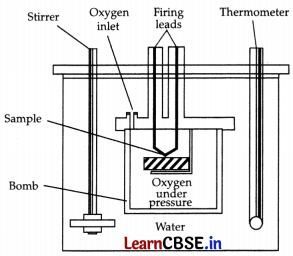
Show that for an isothermal expansion of an ideal gas (i) ∆U = 0 and (ii) ∆H = 0.
Answer:
(a) Bomb calorimeter (1)
(b) Bomb calorimeter is used for the measurement of ∆U.
OR
(i) For one mole of an ideal gas
C
v
= \( \left(\frac{\Delta \mathrm{U}}{\Delta \mathrm{T}}\right)_{\mathrm{v}}\)
or
∆U = C
v
∆T
For isothermal process, T is constant
So, ∆T = 0
∴ ∆U = 0
(ii) ∴ ∆H = ∆U + ∆(pv)
For an ideal gas pv = RT
Since T is constant for isothermal process
∴ ∆T = 0
Alse ∆U = 0
∴ ∆H = 0
![]()
Question 21.
(a) What is Mesomeric effect?
(b) Explain positive mesomeric effect with help of aniline example.
Answer:
(a) Resonance or Mesomeric Effect :
It is defined
as the polarity produced in the molecule by the interaction of two ir-bonds or between a π -bond and a lone pair of electrons present on an adjacent atom. There are two types of resonance or mesomeric effects designated as R or M effect.
(b) Positive Resonance Effect (+R effect) :
Those atoms which lose electrons towards a carbon atom are said to have a +M effect or +R effect.
For example: —Cl, —Br, —I, —NH
2
, —NR
2
OH, —OCH
3
.
Example : Resonating structure of Aniline
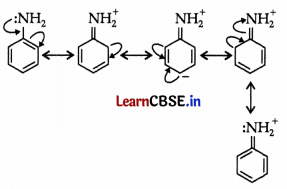
Section-C
This section contains 7 questions with internal choice in one question. The following questions are short answer type and carry 3 marks each. (No internal choice given in Board SQP)
Question 22.
Two particles A and B have wavelength 1A = 5 × 10
-10
m and IB = 10 x 10
-10
m.
(a) Find the frequency, wave number and energies for particle A.
(b) Determine the frequency, wave number and energies for particle B.
(c) Which has more penetrating power and why?
Answer:
(a) For particle A
λ
A
= 5 × 10
-10
m
Frequency V
A
= \(\frac{c}{\lambda_A}=\frac{3 \times 10^8 \mathrm{~m} / \mathrm{s}}{5 \times 10^{-10} \mathrm{~m}}\) = 0.6 × 10
18
= 6.0 × 10
17
s
-1
Wave number v
A
= [/latex]\frac{1}{\lambda_A}=\frac{1}{5 \times 10^{-10} \mathrm{~m}}[/latex]
= 0.2 × 10
-10
m
-1
= 2.0 × 10
9
m
-1
= 2.0 × 10
7
cm
-1
Energy E
A
= \(\frac{h c}{\lambda_A}\) = hv
A
= 6.626 × 10
-34
J s × 6.0 × 10
17
s
-s
= 39.756 × 10
-17
J
= 3. 9756 × 10
-16
J
(b) For particle B
λ
B
= 10 × 10
-10
m
Frequency V
B
= \(\frac{\mathrm{c}}{\lambda_B}=\frac{3 \times 10^8 \mathrm{~m} / \mathrm{s}}{10 \times 10^{-10} \mathrm{~m}}\) = 0.3 × 10
-17
s
-1
(c) Since, the energy of particle A is more than energy of particle B, so particle A has more penetrating power.
Question 23.
How were cathode rays discovered? With the help of suitable experiments show that:
(a) Cathode rays travel in straight lines,
(b) Cathode rays consists of material particles,
(c) Cathode rays consists of negatively charged particles.
Answer:
Faraday began to study electrical discharge in partially evacuated tubes, known as cathode ray discharge tubes. A cathode ray tube is made of glass containing two thin pieces of metal, called electrodes, sealed in it. The electrical discharge through the gases could be observed only at very low pressures and at very high voltages. When sufficiently high voltage is applied across the electrodes, current starts flowing through a stream of particles moving in the tube from the negative electrode (cathode) to the positive electrode (anode). These were called cathode rays or cathode ray particles.
(a) In the absence of electrical or magnetic field, cathode rays travel in straight lines.
(b) The characteristics of cathode rays (electrons) do not depend upon the material of electrodes and the nature of the gas present in the cathode ray tube.
(c) In the presence of electrical or magnetic field, the behaviour of cathode rays are similar to that expected from negatively charged particles, suggesting that the cathode rays consist of negatively charged particles, called electrons. (3)
![]()
Question 24.
In each of the following pairs, which species has a larger size? Explain.
(a) K or K
+
(b) Br or Br
–
Answer:
K is larger in size than K
+
The electronic configuration of K and K
+
are:
K : Is
2
, 2s
2
2p
6
, 3s
2
3p
6
,4s
1
K
+
: Is
2
, 2s
2
2p
6
, 3S
2
3p
6
.
K
+
is formed from K when the later loses its 1 electron.
K → K
+
+ e
–
As seen from the electronic configurations of K and K + , the K + ion has 18 electrons and K atom has 19 electrons but the nuclear charge in both these species is the same (+19). Since K + ion has 1 electron less than K atom, the forces of attraction between the nucleus and the electrons are more strong in K + ion than in K atom. This results in more inward pulling of electrons towards the nucleus in K + ion and hence its size decreases.
(b) Br – is formed by the gain of one electron by Br atom. In Br” the nuclear charge is same as that in the Br atom but the number of electrons has increased. Since same nuclear charge now acts on increased number of electrons, the effective nuclear charge per electron decreases in Br – . The electron cloud is held less tightiy by the nucleus. This causes increase in the size.
Question 25.
If a man submits to a diet of 9500 kj per day and expands energy in all forms to a total of 12000 kj per day. What is the change in internal energy per day? If the energy lost was stored as sucrose (1632 kJ per 100 g), how many days should it take to lose 1 kg? (Ignore water loss for this problem).
Answer:
∆E = 12000 -9500 = 2500 KJ
100 g of sucrose has energy
= 1632 × 10 = 16320 KJ
Now, 2500 kJ of energy is lost in one day.
∴ 16320 Kj of energies is lost in
= \(\frac{1}{2500}\) × 16320
= 6.5 days.
Question 26.
(a) The solubility of silver chloride (AgCl) in water at 25°C is 1.08 × 10
-5
mol L
-1
. Calculate the solubility product of AgCl at this temperature.
(b) The molar solubility of lead iodate is 4.0 × 10
-5
mol/Lat 25°C. Calculate the solubility product of lead iodate at this temperature.
(c) Write the K
sp
expression for Al(OH)3.
Answer:
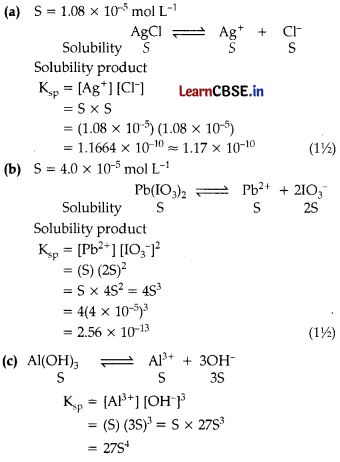
Question 27.
How carbon and hydrogen is detected in an organic compounds?
Answer:
The carbon and hydrogen present in the organic compound is detected by heating the compound with copper (II) oxide. Carbon present in the compound is oxidized to C02 which can be tested with lime water and hydrogen is converted to water which can be tested with anhydrous copper sulphate which turns blue.
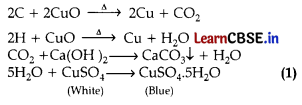
![]()
Question 28.
Rotation around carbon-carbon single bond of ethane is not completely free. Justify the statement.
Answer:
Ethane contains carbon-carbon sigma (s) bond. Electron distribution of the sigma molecular orbital is symmetrical around the internuclear axis of the C-C bond which is not disturbed due to rotation about its axis. This permits free rotation around a C-C single bond. However, rotation around a C-C single bond is not completely free. It is hindered by a small energy barrier due to weak repulsive interaction between the adjacent bonds. Such a type of repulsive interaction is called torsional strain. Of all the conformations of ethane, the staggered form has the least torsional strain and the eclipsed form has the maximum torsional strain. The energy difference between the two extreme forms is of the order of 12.5 kj mol, which is very small. It has not been possible to separate and isolate different conformational isomers of ethane. (3)
Section-D
The following questions are case -based questions. Each question has an internal choice and carries 4 (1 + 1 + 2) marks each. Read the passage carefully and answer the questions thatfolloiv.
Question 29.
Read the following passage and answer the following questions:
Stoichiometry is a branch of chemistry that entails calculating chemical equations. Chemical equations are governed by chemical combination laws. The mass of the reactants equals the mass of the products. The compound obtained by various processes contains the same elements in a set mass ratio. A mole is a unit of measurement equal to 6.022 × 10
23
particles. One mole is also equal to one gram of molar mass. At STP, one mole of each gas has a volume of 22.4 L. The reactive species that is totally consumed in the reaction is known as the limiting reagent, and it determines the amount of products generated. The solution’s concentration is expressed in terms of molarity, molality, and mole fraction, the other two terms are normality and formality.
(a) From the equation: 2SO
2
+ O
2
→ 2SO
3
(b) We understand that 2 moles of SO
2
combines with one mole of oxygen to form 2 moles of SO
3
. Hence, 2 moles of SO
2
is required.
OR
∵ Number of molecules of SO
2
present in 22.4 L at STP = 6.022 × 10
23
∵ Number of molecules of SO
2
present in 11.2 L
at STP = \(\frac{6.022 \times 10^{23} \times 11.2}{22.4}\)
= 3.011 × 10
23
We know from the balanced equation 2 moles of S03 are formed at STP.
Since one mole of a gas at STP occupies 22.4 L, therefore, 2 moles occupy 2 × 22.4L = 44.8L
(c) 2SO
2
+ O
2
→ 2SO
3
.
from the equation:
2 × 80g of SO
3
requires 2 × 64g of SO
2
1g of SO
3
will require 2 × 64/2 × 80
3.2 g of SO, will require (2 × 64/2 × 80) 3.2
= 2.56 g of SO
2
will be required.
Molecules of SO
2
= mass of SO
2
/molecular mass of SO
2
× Avogadro’s number
= (2.56/64) × 6.022
23
= 2.4088 × 10
22
![]()
Question 30.
Read the Passage and answer the following Questions:
Equilibrium in chemicals is a dynamic process. Even after the equilibrium state is reached, the forward and reverse reactions still take place. At equilibrium, the rates of the reactions remain constant, and the relative concentrations of reactants and products remain unchanged. The parameters and characteristics of a system at equilibrium are listed below.
The reaction should be reversible and carried out in closed system The process of equilibrium is dynamic. Equal forward and reverse reaction rates are required. The ratio of reactants to products is not required. However, the quantities of reactants and products will always remain constant until equilibrium has been reached, so that there. is no longer any change in the concentration of the reactants and products. Therefore, chemical equilibrium will exist between the reactants and products.
(a) Mention any two applications of chemical equilibrium.
(b) How would you tell the difference between a system that is reacting so slowly that concentration changes are hard to see and one that has reached chemical equilibrium?
(c) What do the relative concentrations of the reactants vs the products in a particular equilibrium .reaction tell us about each of the following values for K?
(i) when K = 0.96/s
(ii) When K = 1.67/s
Are reactants or products preferred at equilibrium?
OR
PC1
5
, PC1
3
and Cl
2
are at equilibrium at 500K and having concentration 1.59 M PC1
3
,1.59 M Cl
2
and 1.41 M PC1
5
. Calculate K
c
for the reaction,
PC1
5
⇄ PCl
3
+ Cl
2
Question 30.
(a) With the help of Haber’s process, ammonia is manufactured. Since the reaction is reversible Chemical equilibrium is involved. Here, nitrogen gas and hydrogen gas combine to make ammonia. At low temperature, high pressure, and with iron acting as a catalyst, ammonia is produced more readily. Likewise, in the contact process, sulphuric acid is manufactured. Chemical equilibrium is used to convert Sulphur dioxide to sulphur trioxide.
Other applications are:
- To predict the extent of a reaction on the basis of its magnitude.
- To predict the direction of the reaction.
- To calculate equilibrium concentrations.
(b) Le Chatelier’s principle can be used to track any shifts in the reaction with the addition of a constraint, allowing us to distinguish between a system that has reached equilibrium and one that is reacting slowly and making changes in concentrations difficult to monitor (such as concentration, pressure, or temperature). (1)
(c) (i) The concentration of the reactants in the above equilibrium reaction, where K = 0.96/s, is roughly equal to the concentration of the products, therefore neither the reactant- nor product-formation is favoured.
(ii) In the second case the value of K = 1.67/s is greater than 1, concentration of the products in the above equilibrium reaction, is lower than the concentration of the reactants, thus, formation of .the products is favoured. If the value of K is lower than 1 then the reaction proceeds in backward direction as it reflects high concentration of reactants or less concentration of products.
Or
For the reaction,
PC1
5
⇄ PC1
3
+ C1
2
Equilibrium Constant (K
c
) = \(\frac{\left[\mathrm{PCl}_3\right]\left[\mathrm{Cl}_2\right]}{\left[\mathrm{PCl}_5\right]}\)
= \(\frac{(1.59) \times(1.59)}{(1.41)}\)
= 1.79
Section-E
The following questions are long answer type and carry 5 marks each. All questions have an internal choice
Question 31.
Attempt any five of the following:
(a) Dipole moment of hydrogen halides decreases from HF to HI. Why?
(b) What is the covalency of NH
3
, NH
4
+
and [BF
4
]
–
(c) Which of the following compounds does not show resonance: CO(A B03~, SOf”?
(d) Discuss the shape of the following molecules based on VSEPR theory: BC13, SiCl4 A 1
(e) Indicate the number of a and n bonds in

(f) Which hybrid orbitals are used by underlined carbon in the following molecules?
(i) CH
3
— CHO
(ii) CH
3
— CH = CH
2
(g) Explain on the basis of molecular orbital diagram why O
2
should be paramagnetic?
Answer:
(a) Since, the atomic radius increases and electronegativity decreases from HF to HI, therefore dipole moment of hydrogen halides decreases from HF to HI. (1)
(b) Three, four and four (1)
(c) B033 does not show resonance. (1)
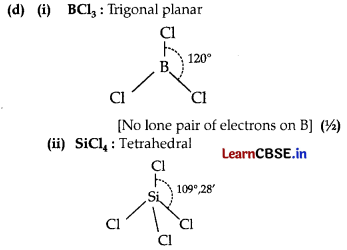
(e) 8 σ Bonds
1 π Bond
(f) (i) sp
2
(ii) sp
2
Question 32.
(a) Explain the chemistry for the fusion of organic compound with Na metal for the detection of nitrogen.
(b) In an estimation of sulphur by carius method, 0.540 g of an organic compound gave 0.999 g of BaSO
4
. Find the percentage of sulphur in the compound. (Atomic mass of Ba = 137 u, S = 32 u)
(c) Draw the resonance structure of aniline, using curved arrow for electronic movements.
OR
Differentiate between the principle of estimation of nitrogen in an organic compound by
(a) Dumas method and
(b) Kjeldahl’s method.
Answer:
(a) Nitrogen, sulphur, halogens and phosphorus present in an organic compound are detected by “Lassaigne’s test”. The elements present in the compound are converted from covalent form into the ionic form by fusing the compound with sodium metal. Following reactions take place:

C, N, S and X come from organic compound. Cyanide, sulphide and halide of sodium so formed on sodium fusion are extracted from the fused mass by boiling it with distilled water. This extract is known as sodium fusion extract.
Test for Nitrogen: The sodium fusion extract is boiled with iron(II) sulphate and then acidified with concentrated sulphuric acid. The formation of Prussian blue colour confirms the presence of nitrogen. Sodium cyanide first reacts with iron(II) sulphate and forms sodium hexacyanoferrate (II)
On heating with concentrated sulphuric acid some iron (II) ions are oxidised to iron (III) ions which react with sodium hexacyanoferrate(II) to produce iron (III) hexacyanoferrate (II) (ferriferrocyanide) which is Prussian blue in colour.

(b) Mass of organic compound = 0.540 g
Mass of BaSO
4
= 0.999 g
percentage of Sulphur
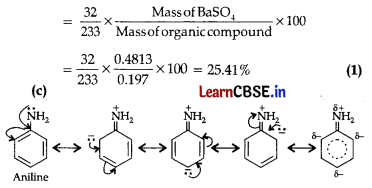
OR
(a) Dumas method:
In Dumas method, a known quantity of nitrogen containing organic compound is heated strongly with excess of copper oxide in an atmosphere of carbon dioxide to produce free nitrogen in addition to carbon dioxide and water.
The traces of nitrogen oxides can also be produced in the reaction, which can be reduced to dinitrogen by passing the gaseous mixture over a heated copper gauge. The dinitrogen produced is collected over an aqueous solution of potassium hydroxide. The volume of nitrogen produced is then measured at room temperature and atmospheric pressure.
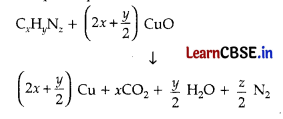
(b) Kjeldahl’s method:
In Kjeldahl’s method, a known quantity of nitrogen containing organic compound is heated with concentrated sulphuric acid. The nitrogen present in the compound is quantitatively converted into ammonium sulphate. It is then distilled with excess of sodium hydroxide. The ammonia evolved during this process is passed into a known volume of H2S04. The acid that is left unused is estimated by volumetric analysis (titrating it against a standard alkali) and the amount of ammonia produced can be determined. The difference between the initial amount of acid taken and that left after the reaction gives the amount of acid reacted with ammonia.
left after the reaction gives the amount of acid reacted with ammonia.
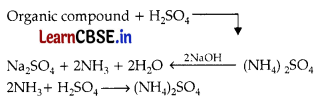
Question 33.
An alkyl halide C
5
H
11
Br (A) reacts with ethanolic KOH to give an alkene ‘B’, which reacts with Br
2
to give a compound ‘C’, which on dehydrobromination gives an alkyne ‘D’. On treatment with sodium metal in liquid ammonia one mole of ‘D’ gives one mole of the sodium salt of ‘D’ and half a mole of hydrogen gas. Complete hydrogenation of ‘D’ yields a straight chain alkane. Identify A,B,C and D. Give the reactions involved.
OR
(a) What do you understand by the following:
(i) Markovnikov’s rule
(ii) Huckel’s rule
(b) An unsaturated hydrocarbon A’ adds two molecules of H2 and on reductive ozonolysis gives butane-1,4-dial, ethanal and propanone.
(i) Give the structure of’A’.
(ii) Write its IUPAC name.
(iii) Explain the reactions involved
Answer:
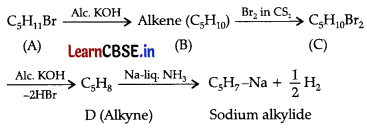
The reactions suggest that (D) is a terminal alkyne. This means triple bond is at the end of the chain. It could be either (I) or (II).

Since alkyne ‘D’ on hydrogenation yields straight chain alkane, therefore structure (I) is the structure of alkyne (D). Hence, the structures of A, B and C are as follows:
(A) CH
3
– CH
2
– CH
2
– CH
2
Br
(B) CH
3
– CH
2
– CH
2
– CH – CH
2
(C) CH
3
– CH
2
– CH
2
– CH(Br) – CH
2
Br
Or
(a) (i) Markovnikov’s Rule: This rule states that, ‘The negative part of the addendum (adding molecule) gets attached to that carbon atom which possesses lesser number of hydrogen atoms, e.g.,
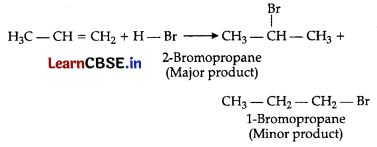
Huckel’s Rule:
This rules states that all planar cyclic conjugated polyenes containing (4n + 2) 7t electrons where, n = 0,1, 2,…… are aromatic in nature. (1)
(b) (i) Two molecules of hydrogen add on ‘A’ this shows that ‘A’ is either an alkadiene or an alkyne.
On reductive ozonolysis ‘A’ gives three fragments, one of which is dialdehyde. Hence, the molecule has broken down at two sites. Therefore, ‘A’ has two double bonds. It gives the following three fragments:
OHC – CH
2
– CH
2
– CHO, CH
3
CHO and CH
3
– CO – CH
3
Hence, its structure as deduced from the three fragments must be
